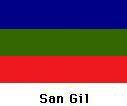 |
 |
XVI. DESCRIPTIONS OF THE OLD TOWN
How were the town and its people during the last centuries. How were we seen by
the eminent historians Gilij, Oviedo, Ancizar and Zamora. What the ancient geography
and history texts say.
About how San GiI was in antiquity, I will permit myself to bring some of the fragments
from the chroniclers who described the customs, importance and idiosyncracies of
the place, approximately two centuries ago. The Jesuit Felipe Salvador Gilij (52)
expresses about the town of San Gil: “San Gil is not far from the San Gil River or
Charal or any other name, up from the town, it is called Monas River”
“Near the city, the river is as wide as a rifle shot, and is crossed by rope bridge
because it is deep and rocky.The water is healthy because it crosses sarsaparrilla
plantations, and the warm climate makes it productive of many fruit products for
its inhabitants who grow every day healthy. These advantages are not superior to
the valor of this population born in this century in this city. Many other so called
cities in order to grow are but small villages”. “Not so the town of San Gil, its
3,000 inhabitants live in beautiful stone houses and temples. Others live in the
countryside. Their government has two ordinary mayors, two perpetual aldermen, a
Royal Ensign with several subordinate ministers who gather the first day of the year
to elect new mayors for San Gil and several local subordinate Spanish Parishes: Socorro,
Simacota, Oiba, Barichara, Mogotes and Zapatoca. This is a singular privilege proper
of a capital town”. “To obtain the mayors’ conrmation, the electors send a paper
appealing to the Santa Fe Audiencia. The subordination to this noble Senate has been
seen in other places but not all”.
In San Gil, to exercise the arms, there are companies of militia of infantry and
cavalry with their ofcers who make this land famous. There are two churches but no
religious members. There is a Priest who is the outside Vicar”. “Another thing I
would like to mention for history, is San Gil commerce of tobacco and cotton, one
taken to other places and the other converted into ne clothes for its inhabitants
and sold with good credit. Second, the cucuisa or maguey, a kind of agave, from its
bers, people make cords, shoes, halters and other useful items. There are several
factories in Guane, the Indian population in the territory near the Curiti River”.
“Third, among the fruits of the region, there is one, cordon de cera, brought
from Italy. It only gives flowers in this foreign land”. (53) The good Priest of
San Gil, Basilio Vicente Oviedo states about San Gil: “It has kindness of first order,
healthy and benign temperament, with good water and fruits of warm climate: sugar
cane, bananas, yucca, cotton and many others. Their neighbors are honest people of
noble nature since their founders, with commerce of cotton textiles and tobacco”.
The notable scientist Ancizar of the Geographic Commission traveled the country
in 1850 to study its possibilities and expressed the following: “San Gil location
and resources secure a solid natural progress. In the genius of its inhabitants predominates
the industrial interest, source of the future greatness of the province which future
is not generally appreciated by the Granadinos”. “The houses in the town’s center
are made out of tiles. They are big and tall and very clean, a sign of the culture
of its inhabitants. There is cleanliness in public places. The poor people do not
have dirty clothes, nor the miserable rags of the inhabitants of the Cordillera.
There is a preference for light dresses in harmony with the warm climate”.(54) Ancizar
dedicates several pages to this town. Finally, Luis F. French, (55) the geographer
of old usage, describes the town in 1892:
“Oppressed by a hill and above a straight band to the right of the Fonce or San
Gil River, there is the City founded in 1620. Its people are rich, industrious and
mercantile.It has beautiful houses of imposing construction, a beautiful iron bridge
and morality reigns. There are benecence houses, a printing ofce and a school, an
almost regal temple, more churches and a hospital.The town was the birthplace of
Diego Fernando y Gomez, Juan Jose Cordero, Doctor Rafael Otero and the jurist Don
Rito Antonio Martinez whose death is felt within the nation limits”. At the beginning
of this century, over fty years ago, the geographer Manuel A Zamora, (56) in his
complete geography, states about San Gil of the times: “San Gil District and City
Capital of the Province of Guanent and of the Department of Galn was founded in 1620
with Indians taken from Guane, and in 1690 she was given the title of Parish. It
is 1099 meters above sea level with a temperature of 22 degrees centigrade. She is
situated on the low lands between the Fonce River and mountains which does not allow
her extension. The town is very clean and has a hospital named San Juan de Dios,
the best in the Department, and two benecence houses run by the Sisters of Charity.
She makes hats, and cotton linen cloth and bedspreads. She cultivates tobacco and
has great commerce. She has a cave with human bones called La Antigua. She has 9,388
inhabitants, colleges, private and public schools, printing, lithography, post and
telegraph ofces, and she is 28 mirimetros (10,000 meters) from Bogot.” She is the
Seat of the Guanent Circuit, of the Judicial District of Galn made of the municipalities
of Aratoca, Barichara, Cabrera, Curiti, Guane, Jordn, Mogotes, Onzaga, Pinchote,
San Joaquin and Valle. Similarly, according to the Laws 63 of 1905 and 32 of June
of 1907 is Seat of Circuit, Notary and Registry with two Notaries and one Registrar.